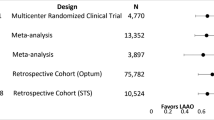Abstract
Objective
The present study evaluated the differences between left atrial appendage occlusion (LAAO) and left atrial appendage resection (LAAR) in terms of the safety and efficacy.
Materials and methods
From January 2018 to August 2022, 94 patients underwent a stand-alone LAAO, and 90 patients underwent stand-alone LAAR in our institution. All of these patients were included in this study. LAAO was performed via left mini-thoracotomy, and LAAR was performed via a left thoracoscopic approach. The patients’ characteristics and perioperative and postoperative data were obtained by retrospectively reviewing their medical records.
Results
The mean age of the patients was 72.4 ± 10.2 (LAAO) and 66.2 ± 9.4 (LAAR) years old (P < 0.05). There were no marked differences in the mean duration of atrial fibrillation (AF) or the ratio of AF type between both groups. The average CHA2DS2-Vasc scores were 4.4 ± 1.6 (LAAO) and 2.7 ± 1.8 (LAAR) (P < 0.05), and the average HAS-BLED scores were 2.9 ± 1.0 (LAAO) and 2.2 ± 1.2 (LAAR) (P < 0.05). The mean operation time was 49 ± 20 min (LAAO) and 34 ± 15 min (LAAR) (P < 0.05). No substantial gaps were detected in preoperative echo-graphic findings between the groups. No significant differences were observed in the amount of intraoperative or postoperative bleeding or the rate of intraoperative massive bleeding events between the groups. Successful LAA closure was achieved in all cases in both groups. Approximately 50% of patients underwent concomitant left pulmonary vein isolation (LPVI) during surgery, indicating no significant differences between the groups (P = 0.872). The early mortality rate was 1.04% in the LAAO group and 0% in the LAAR group (P = 0.132). There was no significant difference in the rate of postoperative LAA stump thrombus between the groups (8.5% in the LAAO group and 6.7% in the LAAR group; P = 0.320). The mean follow-up period was 851 ± 500 (6–1618) days in the LAAO group and 1208 ± 357 (49–1694) days in the LAAR group. Postoperative stroke events were detected in 1 patient in each group (P = 0.432). There was no significant difference in the sinus rhythm recovery rate after LPVI between these groups (31.1% in the LAAO group and 28.6% in the LAAR group; P = 0.763).
Conclusion
There were no significant differences between LAAO and LAAR in terms of the feasibility and the effectiveness as a method for stroke prophylaxis only to selected patients for both procedures, although further studies including the comparison between groups with the same backgrounds to confirm the authentic differences in the clinical results between these procedures.




Similar content being viewed by others
References
Ailawadi G, Gerdisch MW, Harvey RL, et al. Exclusion of the left atrial appendage with a novel device: early results of a multicenter trial. J Thorac Cardiovasc Surg. 2011;142:1002–9.
Blackshear JL, Odell JA. Appendage obliteration to reduce stroke in cardiac surgical patients with atrial fibrillation. Ann Thorac Surg. 1996;61:755–9.
Bleeding during antithrombotic therapy in patients with atrial fibrillation. The stroke prevention in atrial fibrillation investigators. Arch Intern Med. 1996;156:409–16.
Beaver TM, Henda VS, Khanna AY, et al. Thoracoscopic ablation with appendage ligation versus medical therapy for stroke prevention: a proof-of-concept randomizes trial. Innovations (Phila). 2016;11:99–105.
Emmert MY, Puippe G, Baumuller S, et al. Safe, effective and durable epicardial left atrial appendage clip occlusion in patients with atrial fibrillation undergoing cardiac surgery: first long-term results from a prospective device trial. Eur J Cardiothorac Surg. 2014;45:126–31.
Kurfirst V, Mokracek A, Canadyova J, et al. Epicardial clip occlusion of the left atrial appendage during cardiac surgery provides optimal surgical results and long-term stability. Interact CardioVasc Thorac Surg. 2017;25:37–40.
European Heart Rhythm Association, European Association for Cardio-Thoracic Surgery, Camm AJ, et al. Guidelines for the management of atrial fibrillation of the European Society of Cardiology (ESC). Eur Heart J. 2010;31:2369–429.
Ohtsuka T, Ninomiya M, Nonaka T, et al. Thoracoscopic stand-alone left atrial appendectomy for thromboembolism prevention in nonvalvular atrial fibrillation. J Am Coll Cardiol. 2013;62:103–7.
Ohtsuka T, Nonaka T, Hisagi M, et al. Thoracoscopic stapler-and-loop technique for left atrial appendage closure in nonvalvular atrial fibrillation: mid-term outcomes in 201 patients. Heart Rhythm. 2018;15:1314–20.
Ohtsuka T, Nonaka T, Hisagi M, et al. En bloc left pulmonary vein and appendage isolation in thoracoscopic surgery for atrial fibrillation. Ann Thorac Surg. 2018;106:1340–8.
Fumito H, Gillinov AM, Ootaki Y, et al. A novel device for left atrial appendage exclusion: the third-generation atrial exclusion device. J Thorac Cardiovasc Surg. 2008;136:1019–27.
Kanderian AS, Gillinov AM, Pettersson GB, et al. Success of surgical left atrial appendage closure. J Am Coll Cardiol. 2008;52:924–9.
Yoshimoto A, Suematsu Y, Kurahashi K, et al. Early and middle-term results and anticoagulation strategy after left atrial appendage exclusion using an epicardial clip device. Ann Thorac Cardiovasc Surg. 2020. https://doi.org/10.5761/atcs.oa.20-00204.
Author information
Authors and Affiliations
Corresponding author
Ethics declarations
Conflict of interest
The authors declare no conflicts of interest in association with the present study.
Additional information
Publisher's Note
Springer Nature remains neutral with regard to jurisdictional claims in published maps and institutional affiliations.
Supplementary Information
Below is the link to the electronic supplementary material.
Supplementary file1 Video 1. The left atrial appendage (LAA) was exposed through pericardiotomy and the base of LAA was occluded with the AtriClip device (MP4 8723 KB)
Rights and permissions
Springer Nature or its licensor (e.g. a society or other partner) holds exclusive rights to this article under a publishing agreement with the author(s) or other rightsholder(s); author self-archiving of the accepted manuscript version of this article is solely governed by the terms of such publishing agreement and applicable law.
About this article
Cite this article
Yoshimoto, A., Suematsu, Y., Kurahashi, K. et al. A comparison between stand-alone left atrial appendage occlusion and resection as a method of preventing cardiogenic thromboembolic stroke. Gen Thorac Cardiovasc Surg 72, 157–163 (2024). https://doi.org/10.1007/s11748-023-01961-4
Received:
Accepted:
Published:
Issue Date:
DOI: https://doi.org/10.1007/s11748-023-01961-4




